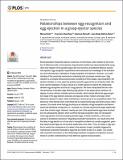Por favor, use este identificador para citar o enlazar a este item:
http://hdl.handle.net/10261/144257COMPARTIR / EXPORTAR:
 SHARE SHARE
 CORE
BASE CORE
BASE
|
|
| Visualizar otros formatos: MARC | Dublin Core | RDF | ORE | MODS | METS | DIDL | DATACITE | |

| Título: | Relationships between egg-recognition and egg-ejection in a grasp-ejector species |
Autor: | Soler, Manuel; Ruiz-Raya, Francisco; Roncalli, Gianluca; Ibáñez-Álamo, Juan Diego | Fecha de publicación: | 2017 | Editor: | Public Library of Science | Citación: | PLoS ONE, 12(2): e0166283. (2017) | Resumen: | Brood parasitism frequently leads to a total loss of host fitness, which selects for the evolution of defensive traits in host species. Experimental studies have demonstrated that recognition and rejection of the parasite egg is the most common and efficient defence used by host species. Egg-recognition experiments have advanced our knowledge of the evolutionary and coevolutionary implications of egg recognition and rejection. However, our understanding of the proximate mechanisms underlying both processes remains poor. Egg rejection is a complex behavioural process consisting of three stages: egg recognition, the decision whether or not to reject the putative parasitic egg and the act of ejection itself. We have used the blackbird (Turdus merula) as a model species to explore the relationship between egg recognition and the act of egg ejection. We have manipulated the two main characteristics of parasitic eggs affecting egg ejection in this grasp-ejector species: the degree of colour mimicry (mimetic and non-mimetic, which mainly affects the egg-recognition stage of the egg-rejection process) and egg size (small, medium and large, which affects the decision to eject), while maintaining a control group of non-parasitized nests. The behaviour of the female when confronted with an experimental egg was filmed using a video camera. Our results show that egg touching is an indication of egg recognition and demonstrate that blackbirds recognized (i.e., touched) non-mimetic experimental eggs significantly more than mimetic eggs. However, twenty per cent of the experimental eggs were touched but not subsequently ejected, which confirms that egg recognition does not necessarily mean egg ejection and that accepting parasitic eggs, at least sometimes, is the consequence of acceptance decisions. Regarding proximate mechanisms, our results show that the delay in egg ejection is not only due to recognition problems as usually suggested, given that experimental eggs are not touched significantly more often. Thus, the delay in egg ejection is mainly the consequence of a delay in the decision to eject, probably triggered by mechanical constraints imposed by eggs that are harder to eject (i.e. larger). Our results offer important information on the relationships between recognition and ejection and contribute to a better understanding of host defences against brood parasites | Versión del editor: | http://dx.doi.org/10.1371/ journal.pone.0166283 | URI: | http://hdl.handle.net/10261/144257 | DOI: | 10.1371/ journal.pone.0166283 |
| Aparece en las colecciones: | (EBD) Artículos |
Ficheros en este ítem:
| Fichero | Descripción | Tamaño | Formato | |
|---|---|---|---|---|
| journal.pone.0166283.pdf | 1,05 MB | Adobe PDF |  Visualizar/Abrir |
CORE Recommender
Page view(s)
272
checked on 18-abr-2024
Download(s)
206
checked on 18-abr-2024
Google ScholarTM
Check
Altmetric
Altmetric
NOTA: Los ítems de Digital.CSIC están protegidos por copyright, con todos los derechos reservados, a menos que se indique lo contrario.
